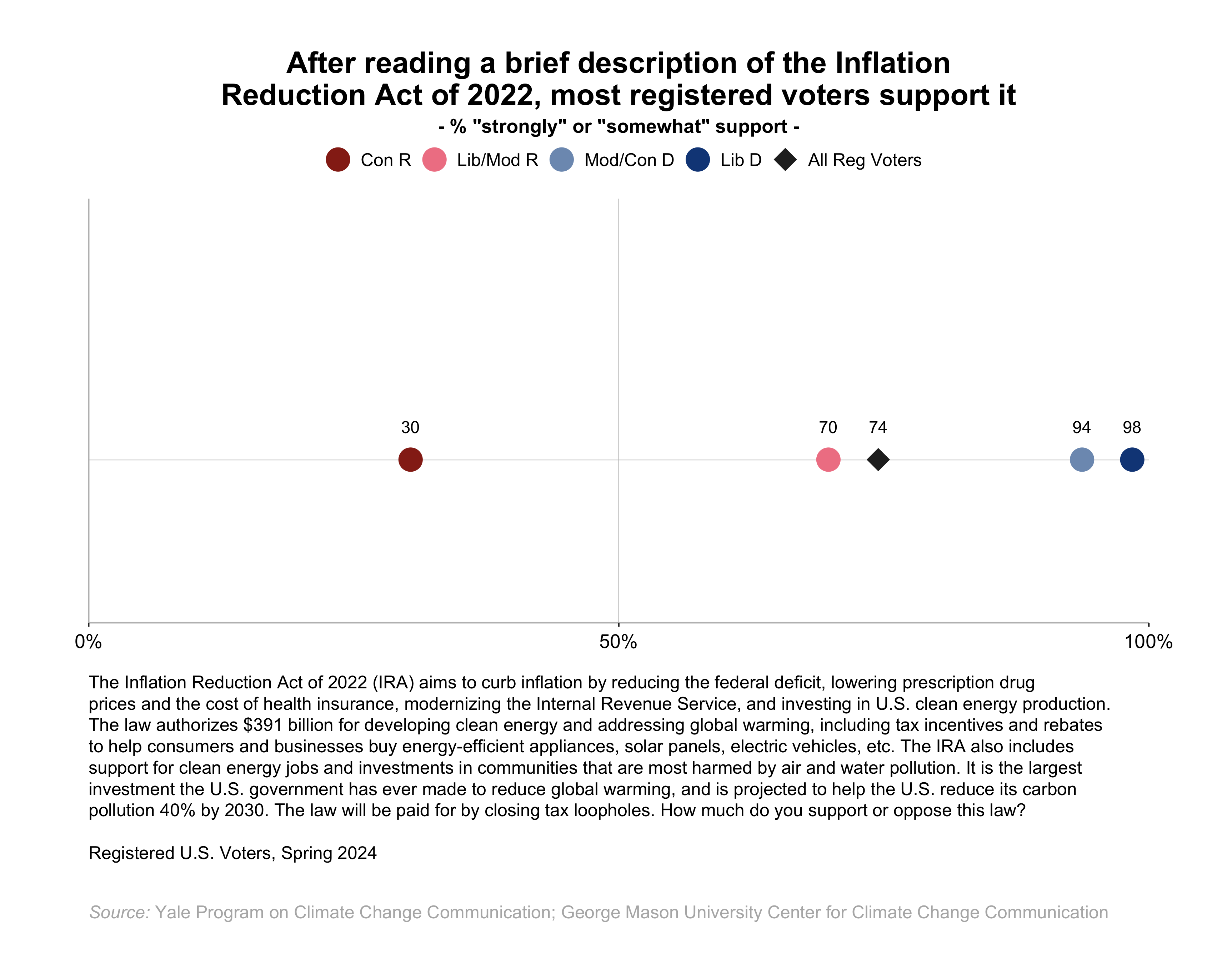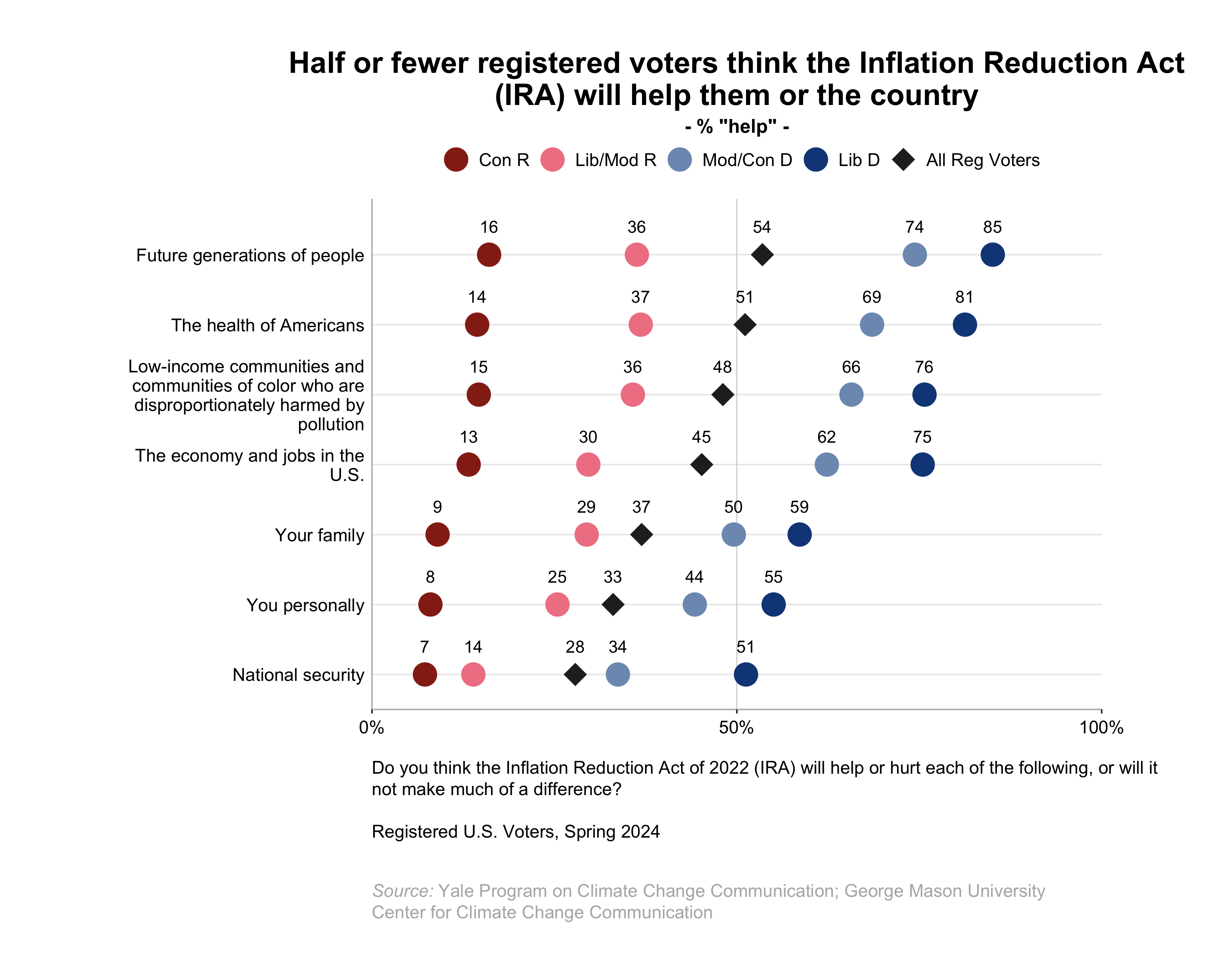Report · Jun 13, 2024
Climate Change in the American Mind: Politics & Policy, Spring 2024
By Anthony Leiserowitz, Edward Maibach, Seth Rosenthal, John Kotcher, Emily Goddard, Jennifer Carman, Matthew Ballew, Marija Verner, Teresa Myers, Jennifer Marlon, Sanguk Lee, Matthew Goldberg, Nicholas Badullovich and Kathryn Thier
Filed under: Policy & Politics
4. The Inflation Reduction Act of 2022 (IRA)
4.1. Most registered voters have not heard much about the Inflation Reduction Act of 2022.
On August 16, 2022, President Joe Biden signed the Inflation Reduction Act (IRA) into law. The law aims to curb inflation by reducing the federal deficit, lowering prescription drug prices and the cost of health insurance, modernizing the Internal Revenue Service, and investing in U.S. clean energy production. The law authorizes $391 billion for developing clean energy and addressing global warming, including tax incentives and rebates to help consumers and businesses buy energy-efficient appliances, solar panels, electric vehicles, etc. The IRA also includes support for clean energy jobs and investments in communities that are most harmed by air and water pollution. It is the largest investment the U.S. government has ever made to reduce global warming, and it is projected to help the U.S. reduce its carbon pollution 40% by 2030. The law will be paid for by closing tax loopholes.
A majority of registered voters (61%) have heard at least “a little” about the Inflation Reduction Act of 2022 (IRA; refer to data tables, p. 56), but only 39% have heard either “a lot” (11%) or “some” (28%) about it. About half of liberal Democrats (49%) have heard “a lot” or “some” about the IRA, while fewer conservative Republicans (40%), moderate/conservative Democrats (37%) or liberal/moderate Republicans (31%) have done so. About four in ten registered voters (39%) have heard “nothing at all” about the IRA.
4.2. After reading a brief description of the Inflation Reduction Act of 2022, most registered voters support it.
After reading a brief description of the Inflation Reduction Act (IRA), a large majority of registered voters (74%) say they support it (41% “strongly support” and 33% “somewhat support”; refer to data tables, p. 57). Nearly all liberal Democrats (98%) and moderate/conservative Democrats (94%) support the IRA, as do seven in ten liberal/moderate Republicans (70%; 13 percentage points higher than one year ago). By contrast, 30% of conservative Republicans support the IRA, while 70% oppose it (including 44% who strongly oppose it).
4.3. Half or fewer registered voters think the Inflation Reduction Act (IRA) will help them or the country.
Registered voters are split as to whether the Inflation Reduction Act (IRA) will help or hurt them or the country. About half or fewer think the IRA will help the following:
- Future generations of people: 54% of registered voters (an increase of 8 percentage points since we last asked this question in the Fall of 2023, and an increase of 12 percentage points since Fall 2022); 85% of liberal Democrats, 74% of moderate/conservative Democrats, 36% of liberal/moderate Republicans, and 16% of conservative Republicans.
- The health of Americans: 51% of registered voters (+6 percentage points since Fall 2023, +16 points since Fall 2022); 81% of liberal Democrats, 69% of moderate/conservative Democrats, 37% of liberal/moderate Republicans, and 14% of conservative Republicans.
- Low-income communities and communities of color who are disproportionately harmed by pollution: 48% of registered voters (+8 percentage points since Fall 2023, +12 points since Fall 2022); 76% of liberal Democrats, 66% of moderate/conservative Democrats, 36% of liberal/moderate Republicans, and 15% of conservative Republicans.
- The economy and jobs in the U.S.: 45% of registered voters (+7 percentage points since Fall 2023, +10 points since Fall 2022); 75% of liberal Democrats, 62% of moderate/conservative Democrats, 30% of liberal/moderate Republicans, and 13% of conservative Republicans.
- Their family: 37% of registered voters (+4 percentage points since Fall 2023, +11 points since Fall 2022); 59% of liberal Democrats, 50% of moderate/conservative Democrats, 29% of liberal/moderate Republicans, and 9% of conservative Republicans.
- Them personally: 33% of registered voters (no statistically significant change since Fall 2023, +11 percentage points since Fall 2022); 55% of liberal Democrats, 44% of moderate/conservative Democrats, 25% of liberal/moderate Republicans, and 8% of conservative Republicans.
- National security: 28% of registered voters (+8 percentage points since Fall 2023, +11 points since Fall 2022); 51% of liberal Democrats, 34% of moderate/conservative Democrats, 14% of liberal/moderate Republicans, and 7% of conservative Republicans.


